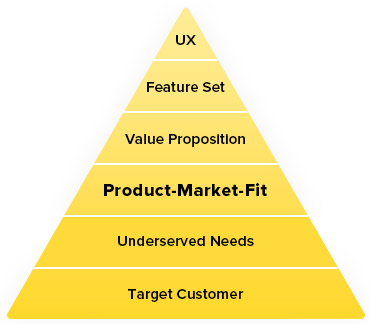The updated Product-Market Fit Pyramid

Dan Olson invented the product Market fit Pyramid. The only thing different from our version of the pyramid is underserved needs come first.
How can that be?
With technology-based computational linguistics software, you can see your customer’s underserved needs and quantify them. Its data-driven science meets the creative brain.
Why do this?
People don’t need more things in their house. They need things that will solve particular jobs to be done. We don’t need to sell people on things they don’t need. That media is costly and nothing good comes of it long term, It’s not good for the environment or for people’s mental state. If you’re not building something that people don’t need, please stop.
When you focus on underserved needs, you’re truly focusing on people and not your product alone.
How is this done?
Using language psychology and computational linguistics, I was curious about a creative way to discover what people really want as opposed to pushing things upon them. In order to accomplish this, I had to break the stereotype of how you discover what people want. I found it through studying language, specifically, the lexical hypothesis. This meant you had to take away limitations on asking questions. You could not have a single-minded view of the efficiency and you had to reduce confirmation bias.
We discovered innovative ways to use language by modeling cognitive patterns, including behavioral and trait patterns. Instead of limiting the efforts to those who write and speak, the idea was to bridge the writer’s language to the non-writer majority. The only way to prove this would be to connect to revenue and profitability via a number of CRMs – about 11,000 of them. Once that was accomplished, we could create causal relationships between language and revenue. We have the responsibility to only use this capability for the benefit of consumers who have limited resources, too many decisions to make, and are confounded by far too many choices.
There are many valuable insights found in human communication that can be bridged to those who are not the writers of the world. By innovating and modeling cognition and traits, we can discover positive uses of Neuroscience and connect to the venture capital and start-up world that desperately needs better answers.